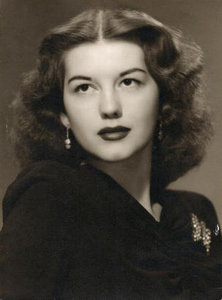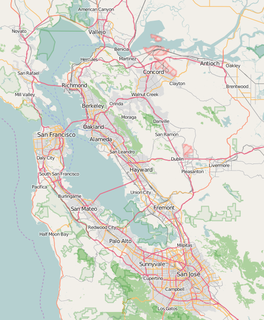
Geraldine Hoff Doyle was an American woman who had been widely and mistakenly promoted in the media as the possible real-life model for the World War II era "We Can Do It!" poster, later thought to be an embodiment of the iconic World War II character Rosie the Riveter. However, it was later shown that the 1942 news wire service photograph likely depicts another young war worker, Naomi Parker.

SS Red Oak Victory is a U.S. military Victory ship of the Boulder Victory-class cargo ship used in the Second World War. She was preserved to serve as a museum ship in Richmond, California, and is part of the Rosie the Riveter/World War II Home Front National Historical Park. She was one of 534 Victories built during World War II, but one of only a few of these ships to be transferred from the Merchant Marine to the United States Navy. She was named after Red Oak, Iowa, which suffered a disproportionate number of casualties in early World War II battles.. The ship was active during World War II, the Korean War, and the Vietnam War.
Permanente Metals Corporation (PMC) is best known for having managed the Richmond Shipyards in Richmond, California, owned by one of industrialist Henry J. Kaiser's many corporations, and also engaged in related corporate activities. These four of the seven west coast Kaiser Shipyards were known for their construction of Liberty ships.

The Ford Richmond Plant, formally the Ford Motor Company Assembly Plant, in Richmond, California, was the largest assembly plant to be built on the West Coast and its conversion to wartime production during World War II aided the United States' war effort. The plant is part of the Rosie the Riveter/World War II Home Front National Historical Park and is listed on the National Register of Historic Places. It currently houses the National Park Service visitor center, several private businesses and the Craneway Pavilion, an event venue.

Margaret Wright was a third-party candidate for President of the United States and a community activist in Los Angeles, California.

The Kaiser Shipyards were seven major shipbuilding yards located on the United States west coast during World War II. Kaiser ranked 20th among U.S. corporations in the value of wartime production contracts. The shipyards were owned by the Kaiser Shipbuilding Company, a creation of American industrialist Henry J. Kaiser (1882–1967), who established the shipbuilding company around 1939 in order to help meet the construction goals set by the United States Maritime Commission for merchant shipping.

The Port Chicago Naval Magazine National Memorial is a memorial dedicated in 1994 recognizing the dead of the Port Chicago disaster, and the critical role played by Port Chicago, California during World War II, in serving as the main facility for the Pacific Theater of Operations. The memorial is located at the Concord Naval Weapons Station near Concord, California, in the United States.

Marina Bay, sometimes referred to as the "Richmond Riviera", is located in Richmond's protected Inner Harbor. It was developed in the mid-1980s in an effort to clean up what had been up to that point the defunct World War II-era Kaiser Shipyards. Marina Bay was planned as an up-scale residential waterfront community with apartments, condominiums, townhouses, and houses. The area is also home to many retail and light-industry businesses. The city considers it one of its success stories and uses it as an template for other projects. The area is served by a private water taxi service departing from the Harbormaster Dock and arriving approximately 35 minutes later next to the San Francisco Ferry Building. Current services includes twice daily morning runs and twice daily evening runs during commute hours. A full WETA Ferry serviced is slated to begin in mid-2018.
Rosemary Corbin is a longstanding Democratic public figure and former mayor of Richmond, California.
Thomas King "Tom" Butt is the current mayor of Richmond, California. He was a former vice-mayor and at city council member for 20 years before being elected mayor. He is a Democrat. He had been on the Richmond City Council since 1995.

During active American involvement in World War II (1941–45), propaganda was used to increase support for the war and commitment to an Allied victory. Using a vast array of media, propagandists instigated hatred for the enemy and support for America's allies, urged greater public effort for war production and victory gardens, persuaded people to save some of their material so that more material could be used for the war effort, and sold war bonds. Patriotism became the central theme of advertising throughout the war, as large scale campaigns were launched to sell war bonds, promote efficiency in factories, reduce ugly rumors, and maintain civilian morale. The war consolidated the advertising industry's role in American society, deflecting earlier criticism.

The four Richmond Shipyards, located in the city of Richmond, California, United States, were run by Permanente Metals and part of the Kaiser Shipyards. During World War II, Richmond built more ships than any other shipyard, turning out as many as three ships in a single day. The shipyards are part of the Rosie the Riveter/World War II Home Front National Historical Park, whose the Rosie the Riveter memorial sits on the former grounds of Shipyard #2. Shipyard #3 is listed on the National Register of Historic Places.

The Kaiser Richmond Field Hospital was the first Kaiser Permanente Hospital and is a historic site resource of the city of Richmond, California, and a contributing property to Rosie the Riveter/World War II Home Front National Historical Park, listed on the National Register of Historic Places. The hospital provided health services for surrounding communities until 1995 when it was replaced by the then state-of-the-art Richmond Medical Center in downtown Richmond. The field hospital is now closed and remains in its original location in South Richmond along Cutting Boulevard.

Betty Reid Soskin is a Ranger with the National Park Service, assigned to the Rosie the Riveter/World War II Home Front National Historical Park in Richmond, California. At age 97, she is the oldest National Park Ranger serving the United States. In February, 2018, she released a memoir, Sign My Name to Freedom.

Naomi Parker Fraley was an American war worker who is now considered the most likely model for the iconic "We Can Do It!" poster. During World War II, she worked on aircraft assembly at the Naval Air Station Alameda. She was photographed operating a machine tool and this widely used photograph was thought to be an inspiration for the poster. Geraldine Hoff Doyle was initially credited as the subject but research by a professor at Seton Hall University set the record straight.
Rosalind P. Walter is an American philanthropist and humanities advocate who is best known for her late 20th and early 21st-century support for public television programming across the United States. Her benevolence has also contributed to the improvement of educational opportunities for disadvantaged youth and the protection of wildlife and open space areas.















